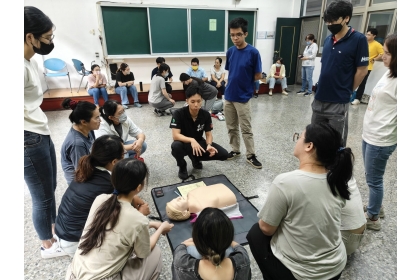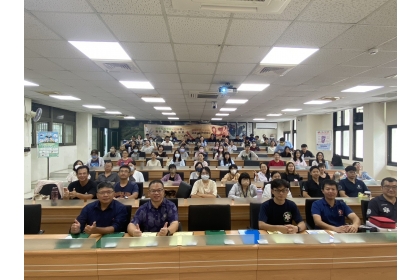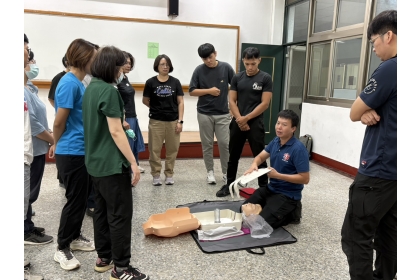NCHU Promotes Emergency Response Awareness and Leads Nation in AED Deployment on Campus
2025-09-30
興新聞張貼者
Unit秘書室
165
To safeguard campus safety and comply with Ministry of Health and Welfare regulations requiring the installation of Automated External Defibrillators (AEDs) in public spaces, National Chung Hsing University (NCHU) has taken proactive steps to promote emergency response awareness. The university has strategically placed AEDs in major campus buildings, with a total of 33 units installed—currently the highest number among universities nationwide—demonstrating its strong commitment to the health and safety of faculty and students.
To maximize the effectiveness of these devices, on September 26 the NCHU Health and Counseling Center, under the Office of Student Affairs, partnered with the Taiwan Disaster Medical Team Development Association to host a “CPR + AED Emergency Response Training and AED Administrator Certification Course.” Nearly 100 faculty, staff, and students took part. The program combined theory with practice, covering CPR instruction, hands-on AED operation, and training in the AED administrator system. Through this systematic approach, participants are expected to respond to sudden cardiac arrest with calm professionalism and seize the critical window for lifesaving intervention.
CPR Training: Strengthening Self-Help and Mutual Aid
The course began with professional medical instructors explaining how to identify and respond to cardiac arrest, emphasizing the importance of the “golden four minutes.” Through detailed demonstrations and practical drills, participants not only mastered CPR techniques but also developed skills in on-site coordination and teamwork, thereby enhancing the overall effectiveness of group emergency response.
AED Practice: Building Familiarity and Confidence
During the hands-on sessions, participants practiced operating AEDs—learning how to quickly place electrode pads, follow voice prompts, and deliver shocks correctly. Repeated practice helped reduce anxiety in high-pressure scenarios, ensuring that faculty and students can skillfully use the devices when emergencies arise, transforming the concept of “AEDs at your side” into real lifesaving action.
Certification System: Ensuring Sustainable Management
The course also introduced an “AED Administrator Certification” system. Participants who passed the evaluation officially became campus AED administrators, responsible for daily inspections, equipment maintenance, and educational outreach. This mechanism ensures the devices remain in optimal condition at all times. By institutionalizing training and management, the program extends beyond knowledge acquisition to establish a sustainable safety network.
A Shared Commitment to Campus Safety
The Office of Student Affairs stressed that building campus safety requires the collective participation of all faculty and students. This training not only enhanced individual emergency skills but also, through inter-unit collaboration and structured systems, created a comprehensive safeguard for the campus. Moving forward, NCHU will continue to promote CPR + AED education and work with professional organizations to further expand AED accessibility in public spaces. The university is committed to making the vision of a “resilient, disaster-ready campus” more than just a slogan, but a shared promise to protect lives.
To maximize the effectiveness of these devices, on September 26 the NCHU Health and Counseling Center, under the Office of Student Affairs, partnered with the Taiwan Disaster Medical Team Development Association to host a “CPR + AED Emergency Response Training and AED Administrator Certification Course.” Nearly 100 faculty, staff, and students took part. The program combined theory with practice, covering CPR instruction, hands-on AED operation, and training in the AED administrator system. Through this systematic approach, participants are expected to respond to sudden cardiac arrest with calm professionalism and seize the critical window for lifesaving intervention.
CPR Training: Strengthening Self-Help and Mutual Aid
The course began with professional medical instructors explaining how to identify and respond to cardiac arrest, emphasizing the importance of the “golden four minutes.” Through detailed demonstrations and practical drills, participants not only mastered CPR techniques but also developed skills in on-site coordination and teamwork, thereby enhancing the overall effectiveness of group emergency response.
AED Practice: Building Familiarity and Confidence
During the hands-on sessions, participants practiced operating AEDs—learning how to quickly place electrode pads, follow voice prompts, and deliver shocks correctly. Repeated practice helped reduce anxiety in high-pressure scenarios, ensuring that faculty and students can skillfully use the devices when emergencies arise, transforming the concept of “AEDs at your side” into real lifesaving action.
Certification System: Ensuring Sustainable Management
The course also introduced an “AED Administrator Certification” system. Participants who passed the evaluation officially became campus AED administrators, responsible for daily inspections, equipment maintenance, and educational outreach. This mechanism ensures the devices remain in optimal condition at all times. By institutionalizing training and management, the program extends beyond knowledge acquisition to establish a sustainable safety network.
A Shared Commitment to Campus Safety
The Office of Student Affairs stressed that building campus safety requires the collective participation of all faculty and students. This training not only enhanced individual emergency skills but also, through inter-unit collaboration and structured systems, created a comprehensive safeguard for the campus. Moving forward, NCHU will continue to promote CPR + AED education and work with professional organizations to further expand AED accessibility in public spaces. The university is committed to making the vision of a “resilient, disaster-ready campus” more than just a slogan, but a shared promise to protect lives.




